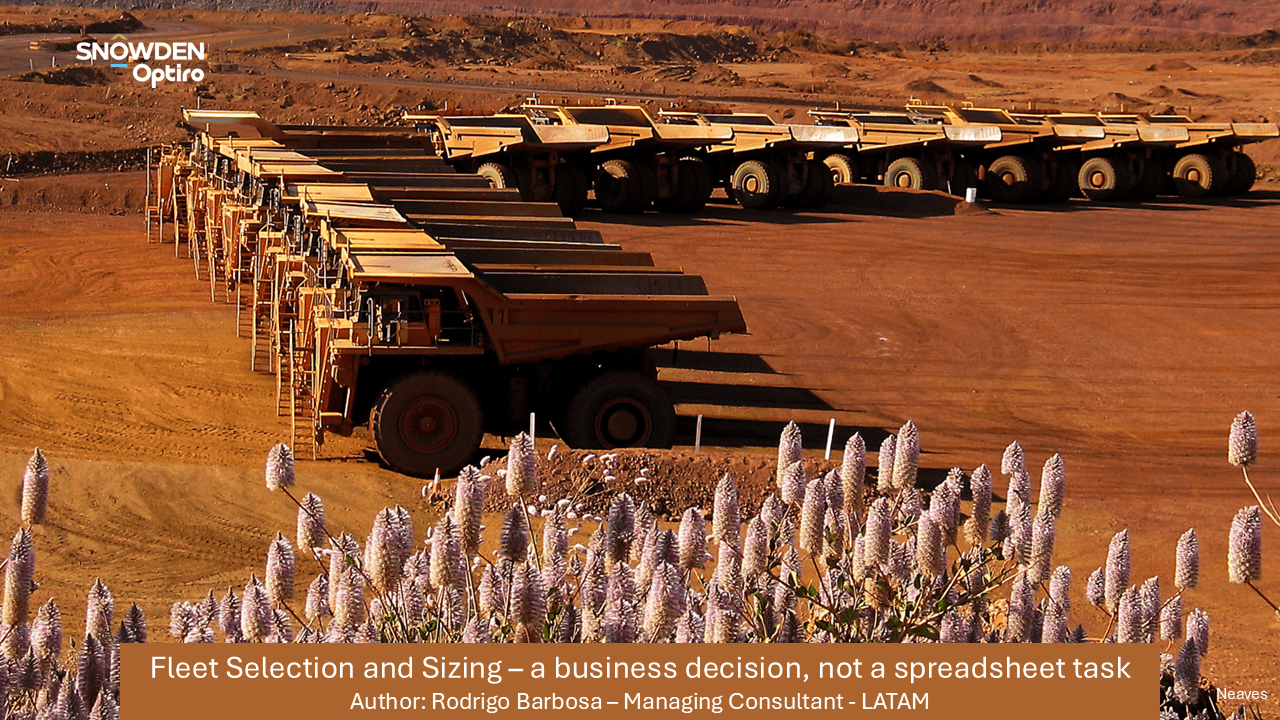

 What to do if you have conditional bias: Get more and closer-spaced data, estimate into larger volumes (this generally works – but not always), think about a change of support if this isn’t possible, and choose an estimation method which doesn’t exaggerate the bias. Author: Ian Glacken
What to do if you have conditional bias: Get more and closer-spaced data, estimate into larger volumes (this generally works – but not always), think about a change of support if this isn’t possible, and choose an estimation method which doesn’t exaggerate the bias. Author: Ian Glacken
 Be aware of the limitations of ID estimation: Inverse distance (ID) is often touted as a viable alternative to Ordinary Kriging (OK), and it can be – but you must appreciate its two or three very serious limitations and correct for these. The limitations are that there is no accounting for data clustering (unlike OK) and the choice of a power is essentially arbitrary. As long as you are aware of these issues, ID can sometimes be used as a ‘check’ technique for OK. Author: Ian Glacken
Be aware of the limitations of ID estimation: Inverse distance (ID) is often touted as a viable alternative to Ordinary Kriging (OK), and it can be – but you must appreciate its two or three very serious limitations and correct for these. The limitations are that there is no accounting for data clustering (unlike OK) and the choice of a power is essentially arbitrary. As long as you are aware of these issues, ID can sometimes be used as a ‘check’ technique for OK. Author: Ian Glacken
 Always look at a range of top-cut (capping) techniques: There is no single ‘magic bullet’ technique for top-cutting a set of data; the top-cut chosen will depend upon the nature of the data, the support of the data and the location of the sample points. Best practice is always to look at two or three different approaches to cutting and see if there is a commonality between one or more methods. If the outcome is sensitive to the top-cut level chosen then it will pay to carry out a sensitivity test on different cuts. Author: Ian Glacken
Always look at a range of top-cut (capping) techniques: There is no single ‘magic bullet’ technique for top-cutting a set of data; the top-cut chosen will depend upon the nature of the data, the support of the data and the location of the sample points. Best practice is always to look at two or three different approaches to cutting and see if there is a commonality between one or more methods. If the outcome is sensitive to the top-cut level chosen then it will pay to carry out a sensitivity test on different cuts. Author: Ian Glacken
 Capping before compositing or after? This is a controversial topic which has adherents on both sides, although most believe that capping should be carried out after compositing, when the data has equal support. If you are going to cap before you composite the data, then the capping should be carried out with the variable as ‘metal’ or accumulation (grade times length), rather than just the assay itself. Author: Ian Glacken
Capping before compositing or after? This is a controversial topic which has adherents on both sides, although most believe that capping should be carried out after compositing, when the data has equal support. If you are going to cap before you composite the data, then the capping should be carried out with the variable as ‘metal’ or accumulation (grade times length), rather than just the assay itself. Author: Ian Glacken
 Don’t ignore the effects of clustering on data statistics: if you don’t correct for clustering any statistics that you derive from the data will be wrong. Don’t assume that just because a set of drilling data is (more or less) on a regular grid that there are no clustering effects. It only takes a few minutes to look at the effects of clustering and it can save (or damn) your project.
Don’t ignore the effects of clustering on data statistics: if you don’t correct for clustering any statistics that you derive from the data will be wrong. Don’t assume that just because a set of drilling data is (more or less) on a regular grid that there are no clustering effects. It only takes a few minutes to look at the effects of clustering and it can save (or damn) your project.
 Remember that declustered data statistics are not perfect: Applying declustering is a good idea for many drillhole data sets, but recognise that it’s not a perfect process. During optimisation of the declustering process, it should be apparent that parameter selection varies the outcome to some degree. Recall this imprecision when comparing whole-of-domain grade statistics after block grade estimation – differences may be within the precision of the declustering process and therefore not necessarily worthy of follow-up action. Author: Paul Blackney
Remember that declustered data statistics are not perfect: Applying declustering is a good idea for many drillhole data sets, but recognise that it’s not a perfect process. During optimisation of the declustering process, it should be apparent that parameter selection varies the outcome to some degree. Recall this imprecision when comparing whole-of-domain grade statistics after block grade estimation – differences may be within the precision of the declustering process and therefore not necessarily worthy of follow-up action. Author: Paul Blackney
 Every step of the resource estimation process should be validated in some way: While this may sound onerous and time consuming, it doesn’t need to be. For instance, check the downhole compositing process by determining the total sample length before and after compositing – it should be the same or nearly the same. The cause of any difference should be determined and either corrected or understood before proceeding Author: Paul Blackney
Every step of the resource estimation process should be validated in some way: While this may sound onerous and time consuming, it doesn’t need to be. For instance, check the downhole compositing process by determining the total sample length before and after compositing – it should be the same or nearly the same. The cause of any difference should be determined and either corrected or understood before proceeding Author: Paul Blackney
 Try to formalise the confidence in your resource categories: at least for a given deposit and/or commodity, try to communicate to all the stakeholders what error (plus or minus, in metal terms) is meant by Measured, Indicated or Inferred Resources. Everyone will have an idea, you just want everybody to have the same idea for the same category. Commercial personnel and Engineers will generally have a more optimistic view of the confidence intervals than Geologists – you all need to be on the same page to manage expectations. Author: Ian Glacken
Try to formalise the confidence in your resource categories: at least for a given deposit and/or commodity, try to communicate to all the stakeholders what error (plus or minus, in metal terms) is meant by Measured, Indicated or Inferred Resources. Everyone will have an idea, you just want everybody to have the same idea for the same category. Commercial personnel and Engineers will generally have a more optimistic view of the confidence intervals than Geologists – you all need to be on the same page to manage expectations. Author: Ian Glacken
 Don’t assume that geological and grade continuity are the same thing: In an ideal world your deposit will have geological and grade continuity – but they are not the same or present to the same degree. Some strongly continuous geological structures can have very poor grade continuity, and some discontinuous structures can in fact have good grade continuity. The scale of examination is important, and the most important scale is the scale of mining. Author: Ian Glacken
Don’t assume that geological and grade continuity are the same thing: In an ideal world your deposit will have geological and grade continuity – but they are not the same or present to the same degree. Some strongly continuous geological structures can have very poor grade continuity, and some discontinuous structures can in fact have good grade continuity. The scale of examination is important, and the most important scale is the scale of mining. Author: Ian Glacken
 The volume-variance relationship is the key to resource estimation; understanding the relationship between samples of a certain size and their variability, and how this variability changes at different volumes (supports), can explain many of the apparent problems in a resource estimate. Using one scale of estimate when you need a smaller or a larger scale is still a very common mistake. Author: Ian Glacken
The volume-variance relationship is the key to resource estimation; understanding the relationship between samples of a certain size and their variability, and how this variability changes at different volumes (supports), can explain many of the apparent problems in a resource estimate. Using one scale of estimate when you need a smaller or a larger scale is still a very common mistake. Author: Ian Glacken
 Ian Glacken – Director of Geology
Ian Glacken – Director of Geology
BSc (Hons), Sc (Min. Geol), MSc (Geostatistics), FAusIMM(CP), CEng, FAIG
Ian is a geologist with postgraduate qualifications in geostatistics, mining geology and computing who has more than 30 years’ worldwide experience in the mining industry. He has worked on mineral projects and given training courses to thousands of attendees on every continent apart from Antarctica! Ian’s skills are in resource evaluation and due diligence reviews, public reporting, training and mentoring, quantitative risk assessment, strategic advice, geostatistics, reconciliation, project management, statutory and competent persons’ reporting and mining geology studies. Ian has a strong mining production background and is a regular auditor for the world’s largest mining companies.
Contact: iglacken@snowdenoptiro.com
 Paul Blackney – Principal Consultant
Paul Blackney – Principal Consultant
BSc (Hons), MAusIMM, MAIG
Paul Blackney is a geologist with more than 30 years’ technical and operational experience. His skills include resource evaluation, technical audits and reviews, geostatistics, reconciliation, grade control, competent persons reporting and project management. Paul provides worldwide technical training and mentoring in resource estimation, quality control and quality assurance, reconciliation and application of the JORC Code and is respected for his focus on the transfer of his knowledge to other geologists.
Contact: pblackney@snowdenoptiro.com
Subscribe here for our podcasts, technical articles and news
